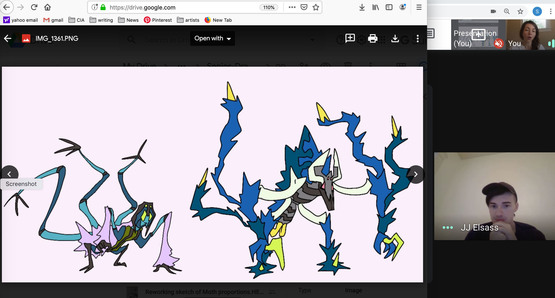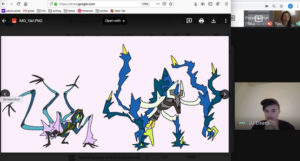
29 Apr Creativity, CIA community stand out in wake of COVID-19
 The pandemic that has kept people out of classrooms and studios hasn’t kept Cleveland Institute of Art (CIA) students, faculty and staff from banding together to continue learning and growing
The pandemic that has kept people out of classrooms and studios hasn’t kept Cleveland Institute of Art (CIA) students, faculty and staff from banding together to continue learning and growing
Juniors Destyni Green and Nick Birnie had been looking forward to seeing their work on view at one of Northeast Ohio’s largest arts events. As students in CIA’s The Artist as Producer course, they’d been part of a semester-long effort to present an exhibition, Handled With Care, at the Survival Kit gallery during the April Third Fridays artwalk at 78th Street Studios in Cleveland.
That plan was just one of the countless turned upside down by the spring 2020 coronavirus crisis. On March 10, CIA announced that it would follow a statewide directive by Ohio Gov. Mike DeWine to take all learning online. The College’s instructional building was closed to in-person classes. Within two weeks, most non-essential businesses and organizations also closed and much of the nation was under orders to stay at home.
Faced with sudden challenges to sharing and learning about art, the CIA community wasted no time in finding new solutions such as video conferencing and using alternate media and processes for artmaking. The students in The Artist as Producer course moved quickly to turn Handled with Care into a virtual exhibition. It will go online April 21. And although that wouldn’t have been the class’s first choice for the show, attitudes are shifting.
“We weren’t sure how a virtual show would work, but a lot of people are starting to fall in love with the idea of bringing people together virtually during this time and what’s going on in the world,” says Green. “We’re finding new meaning in our show, and that’s starting to drive us.”
Adds Birnie, “Everyone is finding different ways to really make this show more personal, rather than just creating an online webpage for work to go on.”
Across the student body, one of the biggest adjustments has been off-site classes. Gone are the day-to-day interactions that sharing CIA’s Gund building provides, not to mention the loss of access to studios and shared equipment. But with those challenges have come opportunities.
“I’m impressed by the students who are really plowing ahead and engaging deeply in their education despite the challenges they’re facing—or maybe because of them,” says Sarah Kabot, chair of Drawing. “Some of the students are really able to take the material skills, conceptual skills and community-building skills they’ve engaged with over the years and employ them in a situation none of us could’ve ever anticipated.”
Industrial Design chair Dan Cuffaro says virtual-learning tools his department uses with project sponsors eased his students’ shift to online coursework. Personal attention has helped, too.
“We communicated immediately and individually with each student, which helped keep them focused and positive,” he adds. “We adjusted project deliverables knowing that students would lose access to some equipment and made minor schedule adjustments.”
Design faculty (and others) have created video content for students to refer to at their convenience. “As one student put it,” Cuffaro says, “‘I like to be able to pause and rewind you!’”
Some COVID-19 transitions have proven trickier than others. CIA Painting chair Lane Cooper says the virtual world has made some lessons more complicated.
“Students, who are inundated with photographic images, tend to default to talking about work in terms of what it is a picture of rather than how it’s made, what it looks like, the colors or composition,” she says. “This challenge is made even greater by necessarily working and engaging through a virtual space.”
Kabot and Cuffaro agree that online communication has been more taxing than traditional lessons—something Kabot experienced firsthand when working with a student to improve a project while in a Google Hangout session
“What used to be a finger point and touch of glue is now four drawings and weird pantomime,” she says.
Challenging but necessary online transitions haven’t been confined to CIA classes.
Reinberger Gallery director Nikki Woods and gallery coordinator Kayli Salzano have been working with faculty to find ways for the gallery to serve them and their students, especially seniors who will be missing an in-person presentation of their final thesis presentations.
“We’re trying to figure out ways to exhibit physical works by students graduating this semester to take place at some point next academic year,” Woods says.
In the Career Center, director Heather Golden is reviewing résumés and cover letters by video conference. Previously scheduled workshops have become webinars on timely topics.
“We’re going to see a lot more virtual and phone interviews, and I want to help set up our students and alumni for success in those kinds of situations, where they’re going to be engaging with employers in this very different way,” Golden says.
At the heart of the response by CIA to COVID-19 has been community. The College created the social media hashtag #CIAcreates to make it easier to see and share the work being created amid social distancing and offer glimpses into home studios. Student Life has also introduced creative hashtags, and it hosts lunchtime Google Hangouts on a regular basis so students can congregate virtually outside of a class setting.
The handful of students still living in residence halls are connecting more meaningfully. Junior Katie Schaefer says, “People who you might just make small talk with before, we’re actually having conversations, which is nice.”
Kabot has seen greater community among her colleagues. She says they have “upped the ante” in terms of how they’re communicating with students and contributing to CIA’s crisis-era demands.
She also has seen students work to foster community. Junior Amani Williams contacted all of the sophomore Drawing majors to offer help.
“She wanted those students to know there was another student there for them if they have questions—which was so impressive,” Kabot says.
Destyni Green says she has seen her classmates rally together in The Artist as Producer class, too, in ways that suggest they’ve already learned lessons central to being professional artists.
“I think it’s a natural response for artists to, when we’re challenged by something, attack it and give it our all. We’re not giving up because we’re in quarantine,” she says. “We’re very driven by what’s going on. I’m really proud of our class and what we’re trying to do right now.”






